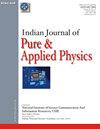不同烧结温度下无铅BCZT陶瓷(Ba0.80Ca0.20Zr0.1Ti0.9)O3的电学性能研究
IF 1.1
4区 物理与天体物理
Q4 PHYSICS, MULTIDISCIPLINARY
引用次数: 0
摘要
由于环境问题,对高性能无铅陶瓷的需求急剧增长。本文采用传统的固态烧结技术,在1380、1400、1420℃的不同烧结温度下制备了无铅(Ba0.80Ca0.20Zr0.1Ti0.9)O3陶瓷。详细的XRD分析表明,在较高的烧结温度1420℃下合成的陶瓷具有纯钙钛矿结构,没有任何杂质。利用阿基米德原理进行密度测量,发现烧结温度越高,密度越大。室温频率相关介电常数研究表明,1420℃烧结陶瓷的介电常数在100 hz ~ 100 kHz频率范围内具有较高的介电常数(εrt= 2665 ~ 2490)。恒定频率(10 kHz)下的介电温度研究表明,在1420℃下制备的陶瓷具有较高的居里温度Tc =77℃。烧结温度从1380℃提高到1420℃,陶瓷的铁电性能得到增强,自发极化值Ps = 7.68 μC/cm2。在1420℃下制备的陶瓷具有较高的居里温度、大频率范围内的室温介电常数和较好的铁电性能,表明该陶瓷可以发展成为具有商业可行性的无铅铁电材料。本文章由计算机程序翻译,如有差异,请以英文原文为准。
Study of Electrical Properties of Lead-free BCZT Ceramic (Ba0.80Ca0.20Zr0.1Ti0.9)O3 at Different Sintering Temperatures
There is a tremendous growth in the demand for high performance lead-free ceramics due to environmental issues. In the present work, the traditional solid-state sintering technique at different sintering temperatures, namely, 1380, 1400 and 1420 oC has been employed to prepare lead-free (Ba0.80Ca0.20Zr0.1Ti0.9)O3 ceramics. Detailed XRD analysis suggests pure perovskite structure for the ceramic synthesized at higher sintering temperature 1420 oC without any impurities. Density measurement using Archimedes principle shows a trend of increased densification with increasing sintering temperature. Room temperature frequency dependent dielectric constant study indicates high value of dielectric constant (εrt= 2665-2490) in the frequency range100 Hz-100 kHz for the ceramic sintered at 1420 oC. Temperature dependent dielectric studies at constant frequency (10 kHz) indicates that ceramic prepared at 1420 oC has high Curie temperature Tc =77 oC. Ferroelectric properties of the ceramics are enhanced by raising the sintering temperature from 1380 to 1420 oC with higher spontaneous polarisation of Ps = 7.68 μC/cm2 corresponding to 1420 oC ceramic. The reasonably high values of Curie temperature, room temperature dielectric constant in the large frequency range and improved ferroelectric properties of the ceramic prepared at 1420 oC indicate that this ceramic can be a good candidate for being developed into commercially viable lead-free ferroelectric material.
求助全文
通过发布文献求助,成功后即可免费获取论文全文。
去求助
来源期刊
CiteScore
1.30
自引率
14.30%
发文量
42
审稿时长
7 months
期刊介绍:
Started in 1963, this journal publishes Original Research Contribution as full papers, notes and reviews on classical and quantum physics, relativity and gravitation; statistical physics and thermodynamics; specific instrumentation and techniques of general use in physics, elementary particles and fields, nuclear physics, atomic and molecular physics, fundamental area of phenomenology, optics, acoustics and fluid dynamics, plasmas and electric discharges, condensed matter-structural, mechanical and thermal properties, electronic, structure, electrical, magnetic and optical properties, cross-disciplinary physics and related areas of science and technology, geophysics, astrophysics and astronomy. It also includes latest findings in the subject under News Scan.

 求助内容:
求助内容: 应助结果提醒方式:
应助结果提醒方式:


